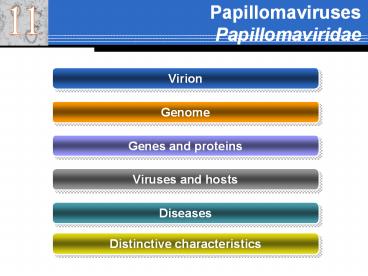Papillomaviruses Papillomaviridae - PowerPoint PPT Presentation
1 / 18
Title:
Papillomaviruses Papillomaviridae
Description:
Title: Introduction to Virology Author: Mike Last modified by: Created Date: 11/27/2006 4:44:40 PM Document presentation format: – PowerPoint PPT presentation
Number of Views:461
Avg rating:3.0/5.0
Title: Papillomaviruses Papillomaviridae
1
PapillomavirusesPapillomaviridae
Virion
Genome
Genes and proteins
Viruses and hosts
Diseases
Distinctive characteristics
2
PapillomavirusesPapillomaviridae
- Virion
- Naked icosahedral capsid (T7).
- Diameter 55 nm.
- Formed from 72 capsomers, pentamers of L1.
3
PapillomavirusesPapillomaviridae
- Genome
- Circular ds DNA, 8 Kb.
- DNA is packaged as minichromosome with cellular
nucleosomal histones.
4
PapillomavirusesPapillomaviridae
- Genes and proteins
- Two transcriptional promoters and two
polyadenylation signals (early and late) on same
DNA strand. - Splicing generates 10 or more different mRNAs.
- Early proteins E1 to E7 stimulate cell
proliferation and enable viral DNA replication. - Late proteins L1 and L2 form capsid.
5
PapillomavirusesPapillomaviridae
- Viruses and hosts
- Over 100 known human papillomaviruses.
- Other hosts cattle, dogs, deer, rabbits, etc.
6
PapillomavirusesPapillomaviridae
- Diseases
- Benign warts at specific sites (skin, mucosa,
larynx) depending on virus strain. - Transmitted by direct contact.
- Some types cause cervical carcinoma, a sexually
transmitted disease and major cause of cancer in
women.
7
PapillomavirusesPapillomaviridae
- Distinctive characteristics
- Difficult to grow in vitro require specialized
raft cultures of epithelial cells. - Replication pattern follows differentiation of
epithelial cells in skin or mucosa. - Early proteins E6 and E7 can transform cells in
vitro, are expressed in cervical carcinomas.
8
Virion
- Papillomaviruses cause warts and other skin and
mucosal lesions
9
Virion
- Oncogenic human papillomaviruses are a major
cause of genital tract cancers - HPV 16 ,18 cervical cancer
- HPV 6, 11 cervical warts
- Papillomaviruses are not easily grown in cell
culture - Papillomavirus genomes are circular,
double-stranded DNA
10
Genome
- The infectious cycle follows differentiation of
epithelial cells
11
Genome
- Viral mRNAs are made from two promoters and two
polyadenylation signals - Viral E1 and E2 proteins bind to the replication
origin and direct initiation of DNA replication
Fig. 11.2 Genetic and transcriptional map of
human papillomaviruses.
12
Genes and proteins
13
Genes and proteins
- Common pathways used by viral oncogenes
14
Genes and proteins
- Viral E7 protein interacts with cell cycle
regulatory proteins, particularly Rb
Fig. 11.5 Papillomavirus E7 protein activates
cell cycle progression.
15
Genes and proteins
- Viral E6 protein controls the level of cellular
p53 protein - Synergism between E6 and E7 and the
predisposition to cancer
16
Genes and proteins
- Cells transformed by papillomaviruses express E6
and E7 gene products from integrated viral DNA - Induce cellular DNA replication
- Prevent the cell from undergoing apotosis
- Future prospects for diagnosis and treatment of
diseases caused by papillomaviruses - Cervical smear test (Pap test) based on the
recognition of morphologically abnormal cervical
cells - warts and precancerous tumors are removed by
surgery or destroyed by liq N2 or laser
17
Vaccines
18
Key Terms
- Apoptosis
- Basal cells
- Condyloma
- Keratinocytes
- Mucosal epithelium
- Pap test
- Proteasome
- Raft culture
- Retinoblastoma (Rb)
- Squamous cell carcinoma
- Tumor suppressor protein
- Ubiquitin
- Ubiquitination































